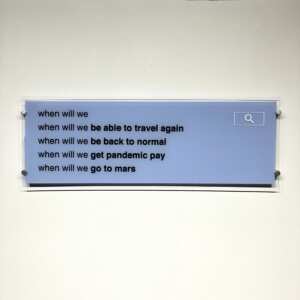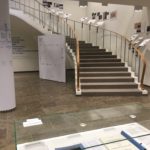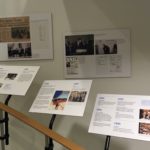I live and work in Vancouver, Canada.
Current Projects
Google-Oracle 2020

“Google-Oracle 2020 #4 | Canada 2020-06-20”
Located @ 1000 Block East Hastings St. Vancouver
While We Wait: Records of Solitude
Group exhibition at Monica Reyes Gallery
March 6 – April 24, 2021 [Saturdays 11-2pm by appointment]

34″ x 12″ Screen Print & Vinyl Text on Plexi
Responding to the pandemic, I created artifacts using plexi and “disposable mask blue” ink to capture our ephemeral google searches. The series of 9 artworks expresses uncertainty as well as humour and hope.
Past Projects
The Archivists
August 2020. The Polygon Gallery Podcast, Episode 11: The Archivists, features a conversation between archivists & educators Jessica Bushey and Howard Besser. Topics covered include the changing role of archivists, documenting the pandemic and activism.
Richard Kinley Gallery: The UNFCCC Story


The Richard Kinley Gallery launched April 2017 at the UN Campus in Bonn, Germany with a permanent exhibition entitled “The UNFCCC Story.” As the curator and archivist on the project, I worked closely with climate change historian, Dr. Joanna Depledge and Yellow Design (Cologne studio) to provide historical evidence in the form of original records, photographs and videos, which highlights the chronological and conceptual development of the United Nations climate change secretariat and international climate change negotiations.
Declarations [Monica Reyes Gallery]


Declarations (2017) are text-based works that draw upon What’sApp communications that reveal the early stages of cross-cultural flirtation. Combining different mobile applications to translate, send and receive texts, I explore how identities are formed and seduction is conducted within the limitations of specific technologies. I have selected 30 translated declarations and embossed them on gold-plated stainless steel charms to be worn around the neck. Turning a fleeting virtual flirtation into a permanent keepsake. Additionally, the declarations are available as a mobile subscription, enabling the collector to experience the thrill of seduction by receiving one declaration per day for an entire month.
The Archival Trustworthiness of Digital Photographs in Social Media Platforms
My doctoral thesis,The Archival Trustworthiness of Digital Photographs in Social Media Platforms explores contemporary photographic practices that utilize mobile phones and social media platforms. Despite the ubiquity of digital photographs as a format, there is little research that examines how the adoption of mobile devices and social media platforms has changed the creation, management and preservation of digital photographs. I approach the trustworthiness of digital photographs accessed and stored in photo-sharing and social networking sites from a multidisciplinary perspective, incorporating literature and studies from journalism, the law and archival science. Original data was generated from a web-based survey and interviews.
In 2015 I created a 3-minute video about my SSHRC-funded PhD research and entered it into the SSHRC Storytellers competition. The video was selected as a finalist, along with twenty-four other top entries that addressed a range of issues—from water security and immigration, to social justice, education and food security—and highlighted how knowledge from the social sciences and humanities helps Canadians understand and improve the world around us (SSHRC Press Release, April 01, 2015). Here is the video:
Through the Trapdoor


In collaboration with Cam Andrews, we create an installation in a storage locker to explore technologies of memory. The project is the result of an invitation to artists to temporarily inhabit a storage rental building, which is scheduled for demolition. We recognize the storage locker’s participation in the memory industry and install obsolete viewfinders and archival kodachrome slides in the exterior walls of the locker, with full spectrum light tubes on the interior for illumination. The images are selected from the personal archives of Ivan Henry Andrews and they document his travels with his wife Kay from 1950 – 1970. The artwork explores the circulation of personal memories in a public arena and its mediation through technologies of memory. The artwork highlights the role of photographic capture, storage and retrieval technologies in what is remembered, personally and collectively. More documentation is available on the Thru the Trapdoor Exhibition Website.
Rogues’ Gallery

In collaboration with Cam Andrews, we create an installation on the corner of Robson and Granville Streets in downtown Vancouver, British Columbia. The project is the result of an invitation to artists to create public art that addresses the history of Vancouver. We recognize the location as the site of the Stanley Cup riots, which had occurred in 2011 and construct a Rogues Gallery from archival records of the Vancouver Police. The images and text are selected from the original arrest registrars, circa 1899-1905 when Vancouver was a young port town and the terminus for the Canadian Pacific Railway. The artwork explores the role of photography as a surveillance technology and addresses the public display of criminal portraiture as a tourist attraction. The artwork highlights the role of photography in objectification and subjection, as well as the challenge to privacy.
Born-digital Images as Reliable and Authentic Records
My masters thesis investigates the creation, use and preservation of born digital images as reliable and authentic records. By studying the photographic practices of professional photographers working with digital technology, I conclude that creators are making decisions that impact the future use of digital photographs as authentic and reliable records. Analysis of image metadata standards and management activities, using the conceptual and methodological framework of archival science and digital diplomatics highlights the limitations of existing photographic workflows as recordkeeping systems. My thesis argues that photographers and archivists need to share expertise, standards and best practices to ensure that the provenance of digital images can be established and protected over time and space. Strategies to ensure the reliability and authenticity of born digital images are discussed: Born-Digital Images as Reliable and Authentic Records.
Digitization of the Collections at the Museum Of Anthropology, UBC

I worked as the Digitization Head at the Museum of Anthropology (MOA) at the University of British Columbia from 2006-2010. During this period I led the digitization of over 35,000 ethnographic objects held in the collections at the museum. As part of a larger renewal project, the digitization of the collections enhances public, originating communities and scholarly access, while supporting preservation activities. The project produced a digital image archives, management and preservation metadata for the digital objects, and an interactive access system made available in the museum galleries and online http://collection-online.moa.ubc.ca. I also provided all print-ready images for the publication, The Museum of Anthropology at The University of British Columbia eds. Mayer and Shelton, which won the Canadian Museums Association 2011 Award for Outstanding Achievement in the Publications category.
Privy Series


I created a series of photo-based works for a solo exhibition at Bjornson Kajiwara Gallery in Vancouver (2006) that explored the boundaries of privacy and community. The body of work is significant because it captures the state of communications prior to the proliferation of mobile phones with cameras and global adoption of social media platforms. By combining visual documentation of graffiti found on bathroom walls with the feet of people occupying the stalls a dialogue is created between strangers. Taken as a whole, the series presents themes of loneliness, outrage, support and criticism – precursor to the selfie and the online troll. The Privy Series was featured on ‘SOCKET’ the Canadian Broadcast Company (CBC) Radio One network program about emerging Canadian artists and provoked a number of responses that reveal shifting socio-cultural attitudes regarding voyeurism and photography, as well as concerns about increasing surveillance.
NOSTALGIA Project

The NOSTALGIA Project was included in Free Manifesta, which was a larger project led by Sal Randolph at Manifesta 4, the European Biennial of Contemporary Art held in Frankfurt, Germany in 2002. As part of Free Manifesta, over 225 artists participated in free public art projects that took place around Frankfurt am Main, as well as through telephone, the Internet and mail systems. NOSTALGIA involved a number of components: 1) the creation of “hero” cards that were given-out for free on location. The first hero card was a reproduction of a photograph taken in the 1970’s by my grandmother of my American cousin wearing his football team uniform with overlaid text “hero”; 2) the creation of short videos with visitors to Manifesta 4, in which they respond to the question “Who is your hero?” and “Why?”; and 3) the creation of an interactive online database of all the short videos. The Nostalgia project predates most social media platforms, therefore it required extensive production to create an online platform of multimedia works that could be viewed and searched. Again, this project is an early exploration into sharing personal opinions online. As the subjects discuss the concept of heroism, cultural values about status, success and community are revealed. This body of work also addresses the relationship between archival photographs, storytelling and memory.
